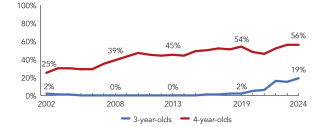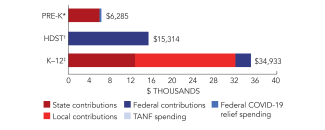
State of Preschool
New York
Access Rankings
Resource Rankings
Total Benchmarks Met
Overview

During the 2023-2024 school year New York preschool enrolled 158,956 children, an increase of 3,444 from the prior year. State spending totaled $940,121,477, with an additional $58,992,850 in federal recovery funds to support the program, up $55,046,901 (6%), adjusted for inflation, since last year. State spending per child (including federal recovery funds) equaled $6,285 in 2023-2024, up $215 from 2022-2023, adjusted for inflation. New York met 7 of 10 quality standards benchmarks.
What's New

The FY 2024 enacted state budget included an additional $100 million for the Universal Prekindergarten Program (UPK) and $50 million for a new competitive Statewide Universal Full-Day Prekindergarten Program (SUFDPK) grant. The requirements for SUFDPK funding were revised in 2023-2024 allowing districts to access funding with higher per student rates first. The New York State Board of Regents priority is to provide truly universal prekindergarten for 3-and 4-year-old children by 2035. The Office of Early Learning’s capacity increased and continues to increase so more site visits and professional learning opportunities were provided. New York State is also updating preschool regulations to better support the needs of emergent multilingual learners. In September 2024, New York was one of 10 states and D.C. awarded a 3-year federal renewal Preschool Development Grant B-5 (PDG B-5) totaling $11,000,000 annually. The PDG B-5 renewal grant is intended to carry out the strategic plans developed with the 2023 planning grant. Funding will be used, in part, to provide a professional development event for P–3 educators that the Office of Early Learning will plan and host.
Background
In 1998, New York State began its UPK with the goal of making prekindergarten education available to all 4-year-olds in the state. In 2007, the Targeted Prekindergarten Program merged with UPK. In 2013-2014, the state continued targeting its pre-K funding, launching the New York State Priority Prekindergarten Program (NYSPPK) offering competitive grants for new full- and half-day slots for high-need children in low-income school districts and enabling districts to convert half-day slots to full-day. In 2014-2015, the SUFDPK competitive grant for full-day pre-K was launched. Most of this funding ($300 million) went to New York City; $40 million was used to expand full-day pre-K in the rest of the state. Funding could be used to create new full-day slots or convert existing half-day slots to full-day. In 2015-2016, the Expanded Prekindergarten for 3- and 4-Year-Old Students grant began, creating new slots for 3- and 4-yearolds. New York also was awarded a 2014 federal Preschool Development Grant supporting enrollment of low-income 4-year-olds in five school districts. Ninety-four percent of children were served in full-day programs in 2023-2024.
The New York Board of Regents adopted revised comprehensive, multi-domain early learning standards in 2011 which are aligned with state K–3 standards, state college and career ready standards, and the New York State Common Core Learning Standards. In 2012, the state implemented a voluntary QRIS called QUALITYstarsNY. In 2017-2018, all districts receiving state funds for pre-K were required to adopt approved quality indicators within two years, including, but not limited to, valid and reliable measures of environmental quality, the quality of teacher-student interactions, and child outcomes. To document districts’ progress in implementing the approved quality indicators, the State Education Department (SED) implemented the NYS Pre-K Self-Assessment. Districts rate themselves as Implemented, In Process, or Not Implemented. For each area marked In Process or Not Implemented, districts develop Quality Improvement Action Plans to assess strengths and weaknesses in seven areas of program quality. SED staff review plans and provide feedback to inform technical assistance and monitoring. Beginning in 2023-2024, all districts are required to submit action plans to outline their Prekindergarten programming for the current school year in annual applications.
New York State Administered Prekindergarten Program
Access
Resources
| Total state pre-K spending | $999,114,327 |
| Local match required? | No |
| State Head Start spending | $0 |
| State spending per child enrolled | $6,285 |
| All reported spending per child enrolled* | $6,285 |

*Pre-K programs may receive additional funds from federal or local sources that are not included in this figure. †Head Start per-child spending includes funding only for 3- and 4-year-olds. ‡K–12 expenditures include capital spending as well as current operating expenditures.
New York Quality Standards Checklist
| Policy | Requirement | Benchmark | Meets Benchmark? |
|---|---|---|---|
For more information about the benchmarks, see the Executive Summary and the Roadmap to State pages. | 7*benchmarks met | ||
| Early Learning & Development Standards Benchmark | Comprehensive, aligned, supported, culturally sensitive | Comprehensive, aligned, supported, culturally sensitive | |
| Curriculum Supports Benchmark | Approval process & supports | Approval process & supports | |
| Teacher Degree Benchmark | BA* | BA | |
| Teacher Specialized Training Benchmark | ECE | Specializing in pre-K | |
| Assistant Teacher Degree Benchmark | Level I Teaching Assistant Certification (public); HSD (nonpublic) | CDA or equivalent | |
| Staff Professional Development Benchmark | 175 hours/5 years (teachers only); Coaching (first year public school teachers only) | For teachers & assistants: At least 15 hours/year; individual PD plans; coaching | |
| Maximum Class Size Benchmark | 20 (3- & 4-year-olds) | 20 or lower | |
| Staff to Child Ratio Benchmark | 1:9 (3- & 4-year olds) | 1:10 or better | |
| Screening & Referral Benchmark | Vision, hearing, health & more | Vision, hearing & health screenings; & referral | |
| Continuous Quality Improvement System Benchmark | Annual structured classroom observations (UPK); Data used at the local level only (UPK); Determined locally (SUFDPK) | Structured classroom observations; data used for program improvement | |
* Indicates that while policy meets the benchmark, it is not being implemented fully
